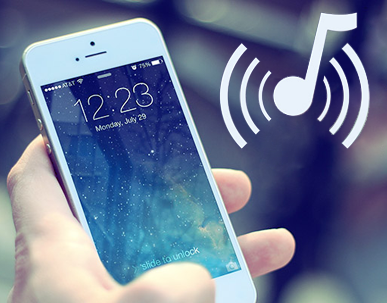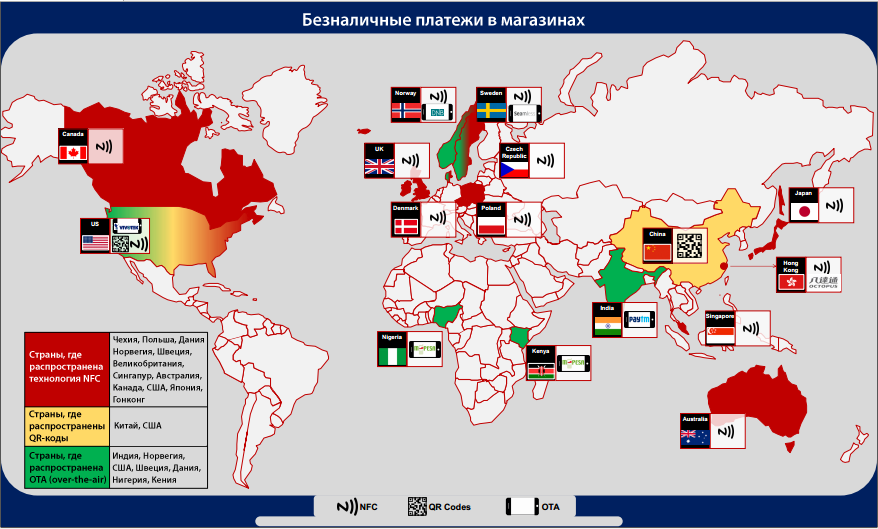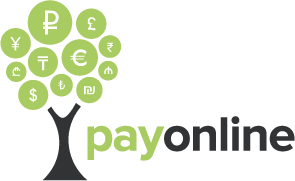Sound barcode is an alternative to NFC that does not require special hardware
 In this article, the author presents a sound payment confirmation technology as a possible alternative to the widely accepted NFC technology. Below are the practical cases of the use of sound in payment transactions.
In this article, the author presents a sound payment confirmation technology as a possible alternative to the widely accepted NFC technology. Below are the practical cases of the use of sound in payment transactions.Companies and individuals are increasingly using NFC, because the technology provides significant advantages in terms of increasing the speed of work and improving user experience. Today, the world's leading phone makers, such as Apple, Xiaomi, Huawei, Samsung and others, are actively promoting proprietary payment solutions integrated into their smartphones and using Near Field Communication technology. All modern smartphones are equipped with NFC-tags, which creates the necessary conditions for the development and marketing of a large number of different solutions.
There are over a billion non-NFC mobile device owners in the world
According to some estimates , today there are about 2.08 billion smartphones in circulation. However, not all smartphones support NFC technology, and most owners of old models do not have access to a contactless payment method.
According to reports , for 2016 in the world uses just over 1 billion devices that support NFC technology. This means that there are over a billion users (mostly in developing countries) who have telephones but cannot make contactless payments. In the eyes of companies specializing in the promotion of NFC payments, these are “missed opportunities”.
')

The issue of access to contactless payments becomes even more acute if we consider the part of the world's population that does not have mobile devices at all. There may be various reasons, such as price or other factors. The part of the population that cannot afford a modern device and replaces it with cheaper and older versions also falls into the group without access to contactless payments. Estimates show that this is a fairly large group of the population - only in the USA about 28% of the population do not have smartphones at all. In the UK, this figure reaches 32%, and in Canada - 33%.
Sound payments - barrier-free technology for developing countries
Sound-based payments may not be a “breakthrough” in developed markets, where the penetration rate of smartphones with NFC chips is high and the proportion of sellers who have POS-compatible NFC-compatible terminals is relatively high. But for countries with a large population, high smartphone penetration, but a lagging business ecosystem and outdated terminals (in India, for example, only ~ 40,000 NFC devices with EMV support), payments based on sound could be an excellent alternative. This technology usually works through the application, and the user does not need any special hardware, such as an NFC tag ( it is expected that ~ 30% of POS terminals around the world will still not support NFC by 2019).
Sound payment solutions use sound waves to make short-range offline contactless payments. The technology itself is not new. Several years ago, experts promoted it as a good alternative for two reasons: 1) the main and essential condition of this technology is the presence of a speaker and microphone, which are ubiquitous; 2) the technology does not require any special hardware or device pairing.
Moreover, a few years ago, MIT specialists suggested that using sound payments will globally simplify the process of buying and selling products for users around the world, including those who do not have a smartphone. Sound can also be used to exchange data between completely different devices, which is very convenient if we consider the constantly increasing number of devices we use.
Companies operating in the field of sound payment solutions
Despite the fact that the concept and technology of sound payments appeared far from yesterday, the technology itself was not widely spread in the world. All attempts of its mass use always remained local and did not attract much attention.
Naratte - Zoosh - Verifone
In 2011, Naratte, the developer of Zoosh technology (later acquired by Verifone), promoted sound payments amid the slow spread of NFC. The company, based in Sunnyvale, California, for two years worked on the audio processing technology necessary to adequately protect payment data and work effectively even in noisy environments.
As explained in the MIT Technology Review , in order to use Zoosh technology, it is necessary to keep your phone within six inches from any other phone with a Zoosh app or a special sensor connected to the store terminal for a short time. To identify the device, they exchange short access keys encoded into ultrasound signals - the whole process takes less than a second. Users can then make debit or credit transactions in points or cash, and also exchange data between devices, for example, contact information.
In 2013, Alipay launched a payment system in the Beijing subway that used sound waves to connect smartphones to vending machines. As reported in the TechCrunch blog, the sound payment system was introduced into the Alipay Wallet mobile app in January and used white noise generated by the smartphone to transfer digital data to another device. Initially, the system was used for transactions between smartphones. Later, in the Beijing subway, the system was first used at a payment kiosk to conduct a consumer transaction.
In the same year, Verifone launched the Way2ride app for New York taxis (and in 2014 went to Philadelphia). Way2Ride uses Zoosh's proprietary audio technology to check-in passengers for a trip, transferring payment information securely through the cloud. In the Way2ride application , Verifone first applied Zoosh technology for commercial purposes, using smartphone speakers and microphones to securely exchange encrypted data between devices. This allowed application developers to unlock the full potential of smartphones without NFC support in terms of implementing one-touch functionality in NFC solutions.
Paytm
Of the more recent examples, Paytm can be cited, which in January 2016 announced the upcoming launch of the new “sound payment” feature in its smartphone app, which will allow money transfers and payments using ultrasonic waves.
“In a short while, users of the Paytm application will be able to touch the“ sound payment ”icon, says the head of software development, Nitin Mishra, and transmit ultrasonic signals of a certain frequency, in which information about the amount of payment and customer credentials are encrypted.
Ultracash - Yes Bank
A start-up company Ultracash , located in the city of Bengaluru, based on a patented Indian technology, developed its own solution, which uses high-frequency sound waves that are inaudible by people to transfer data between two mobile devices. Since the technology uses a speaker and microphone, it is available on all phones and does not require special equipment.
In February, Ultracash entered into a partnership = with Yes Bank, a private bank, to launch payment transactions using sound waves. This collaboration enabled Ultracash to bring Yesbank-branded mobile wallets to the market and use the bank’s IMPS platform to process instant contactless transactions. Technology Ultracash 'Tap and Pay' works on any devices, does not require any special equipment and NFC-chips.
ToneTag - Yes Bank
Yes Bank also collaborates with ToneTag , which offers its short-range technology for the realization of sound contactless payments in a Yes Pay mobile wallet. The technology will allow wallet owners to make payments in retail outlets through their mobile phones, without using plastic cards.
“Thanks to the cooperation with ToneTag, Yes Pay wallets users can appreciate the payment technology that is close to NFC, but without the need for special hardware. This is a significant improvement over current technologies, such as QR codes used to pay for purchases in stores, ”said Kumar Abhishek, CEO of ToneTag.
The same ToneTag in February of this year began to cooperate with MoboMoney , the NFC payment platform launched in December 2015 by the information technology provider Tech Mahindra . Tech Mahindra, together with a partner, plans to provide its service throughout India and is focused on a wide coverage of mobile devices and retail outlets.
“In addition to trade transactions, this technology will help realize peer-to-peer P2P transfers between two mobile devices. The buyer initiates the payment, and the seller confirms it, after which data is transmitted using audible or inaudible sound vibrations. Since the technology is compatible with old POS terminals, it allows contactless payments to be made on an already existing network of 1.2 million POSs across India. <...> At the same time, this will enable approximately 14 million merchants in India to accept non-cash digital payments using their phones, and the investment will be either minimal or generally zero, ”commented Tech Mahindra on its website.
Animal Systems - Chirp
There is another interesting company called Animal Systems , which developed Chirp - a sound bar code. As Animal Systems itself claims, it is the most reliable sound transmission technology in the world, which is used by leading brands in more than 90 countries. Using Chirp technology, data and content can be encoded into a unique audio stream. Any device with a speaker can transmit a signal - “chirp”, and most devices with a microphone can decode them.
At the same time, users do not need to connect to the Internet, request contact details of another device or pair them. The system is designed for those cases when the use of existing network technologies causes difficulties or becomes impossible.
Soundpays
Probably one of the most interesting players in this area is the Torpolo -based Soundpays company, which has developed a mobile wallet that allows you to conduct secure transactions in a noisy environment using ordinary sound waves. All purchases are transferred via sound to the Soundpays mobile wallet, and then the required amount is deducted from the user's debit account or credit card. During the entire payment process, banking information is not stored and is not transmitted.
But this is not the most interesting part - the technology allows you to connect your smartphone to a TV or laptop and purchase the advertised products immediately. Imagine you are watching ads, and you wanted to buy an advertised product. Naturally, the first thing that comes to your mind is to call and order it or go to the company's website and find the product there. Soundpays eliminates unnecessary actions and allows you to simply open the application and place an order. The company opens up unlimited opportunities for making impulse purchases without giving the user a second to change their decision.
Soundpays embeds inaudible sound waves into any broadcast content and allows you to instantly buy advertised products. The solution integrates with online, OTT and VOD broadcasts, expanding shopping opportunities and making truly impulse acquisitions a reality.

Source: https://habr.com/ru/post/399297/
All Articles